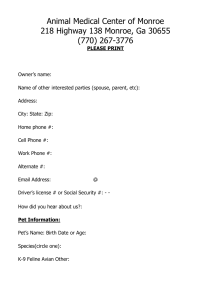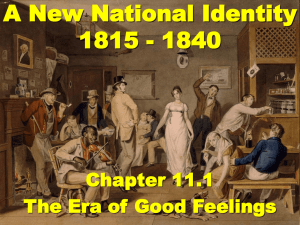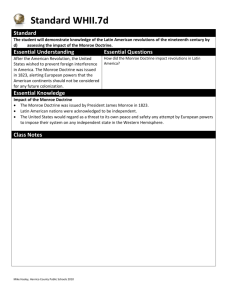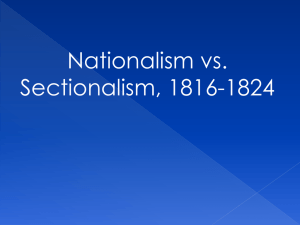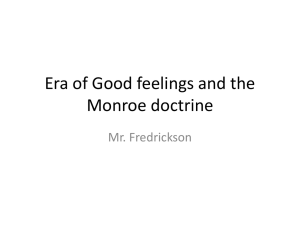Measures of Endurance and Truth
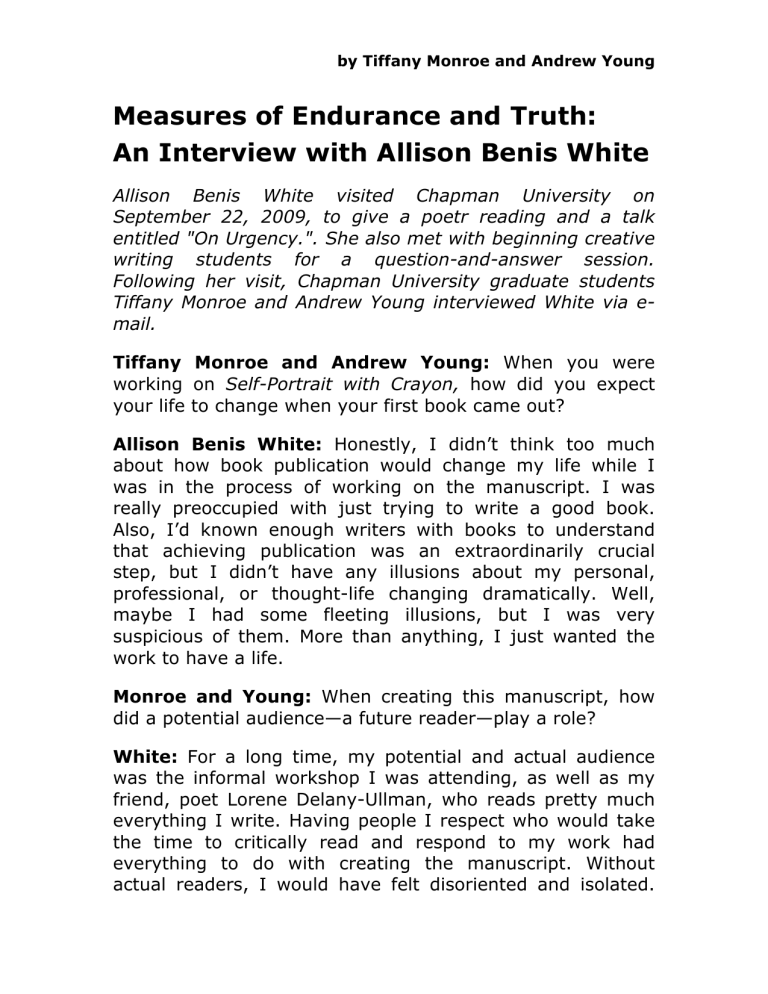
by Tiffany Monroe and Andrew Young
Measures of Endurance and Truth:
An Interview with Allison Benis White
Allison Benis White visited Chapman University on
September 22, 2009, to give a poetr reading and a talk entitled "On Urgency.". She also met with beginning creative writing students for a question-and-answer session.
Following her visit, Chapman University graduate students
Tiffany Monroe and Andrew Young interviewed White via email.
Tiffany Monroe and Andrew Young: When you were working on Self-Portrait with Crayon, how did you expect your life to change when your first book came out?
Allison Benis White: Honestly, I didn’t think too much about how book publication would change my life while I was in the process of working on the manuscript. I was really preoccupied with just trying to write a good book.
Also, I’d known enough writers with books to understand that achieving publication was an extraordinarily crucial step, but I didn’t have any illusions about my personal, professional, or thought-life changing dramatically. Well, maybe I had some fleeting illusions, but I was very suspicious of them. More than anything, I just wanted the work to have a life.
Monroe and Young: When creating this manuscript, how did a potential audience—a future reader—play a role?
White: For a long time, my potential and actual audience was the informal workshop I was attending, as well as my friend, poet Lorene Delany-Ullman, who reads pretty much everything I write. Having people I respect who would take the time to critically read and respond to my work had everything to do with creating the manuscript. Without actual readers, I would have felt disoriented and isolated.
by Tiffany Monroe and Andrew Young
Lorene, in particular, encouraged me that there was an audience for the work beyond her, which helped reduce the inevitable doubt and loneliness that comes with trying to write a book.
Monroe and Young: How long were you sending your manuscript out before it got published? What changes did you make to Self-Portrait with Crayon while you were sending it out?
White: I sent the manuscript out for about three years without making any major changes. I tinkered with a few words, and once, in a panic, during the third year, I rearranged the first few poems.
Another change I made was the title; it was originally called
Curtainfall, but when I started thinking about first impressions and what was memorable, again in the third year, I changed the title to Self-Portrait with Crayon.
But overall, the manuscript was done when I started sending it out.
Monroe and Young: In hindsight, did the experience of having a full-length collection match your expectations?
White: Once I knew the book was going to be published, I was sort of tunneled in my thinking about presentation
(margins, font, the cover, etc.). So the initial experience was simply relief that the book looked good and was readable.
After that, there were many surreal milestones, like seeing my Amazon page, and signing the book, which I'd never wholly considered or imagined.
Monroe and Young: How have you felt about critical responses to your work?
White: I’m excited that there’s a critical response to the book at all! A first book of poetry from a small university press is not likely to receive a great deal of attention, so I
by Tiffany Monroe and Andrew Young didn’t expect to be widely reviewed. But this fall, the book was reviewed in ForeWord Magazine, Mid-American Review, and Virginia Quarterly Review . Also, there are reviews forthcoming in Boston Review and Sentence , for which I'm very grateful.
Monroe and Young: How have audiences responded to your poetry?
White: At readings, most people have been very gracious and supportive, which is wonderful because readings are often challenging for me. I understand that it's vital to participate in readings, and from a distance, I'm thrilled to do so. But like most people, I get stage fright and have trouble being "in my body" while I read. Attending many readings in the past did help me choose which poems to read and which to avoid (I try to anchor the reading with the poems that contain narrative strains, as opposed to the more purely associative pieces), as well as honor the maxim that less is more—I try not to read for more than twenty minutes in order to respect the attention of the audience.
Monroe and Young: How do you think the market responds to alternative forms of poetry, such as the prose in your collection?
White: When I was sending out the manuscript, I worried that a collection of prose poems might be an immediate turn-off to some book contest screeners (i.e., "the market"), and that the manuscript wouldn’t be considered simply because of that. But the truth is, there are always readers who will be attracted to certain forms, subject matter, aesthetic, and so on, and there will always be readers who will have distaste for others. I tried to retain my own conviction about the rightness of the form for this manuscript and trust that it would find a readership.
by Tiffany Monroe and Andrew Young
I suppose I view form through the lens of time and emotional posture. Self-Portrait with Crayon is rooted a great deal in the act of waiting, as it comes from a place in my mind where I was covertly waiting for years for my mother to return. In this sense, the prose form gave me a sense of space that aligned with waiting. At the time, writing traditional verse caused me to feel as if I was rushing toward lyric epiphany. I'm not arguing that breaking lines causes this kind of urgency—this was just my experience at the time, with the subject matter of the book. Somehow the prose form served my particular psychic construct of time and grieving, so when I say "the rightness of the form," I mean that the circumstance of the book's origin was facilitated by the boundaries (the boundarylessness) of the form, and ultimately, the poems couldn't have come to life effectively otherwise.
Monroe and Young: What role do you see prose poetry playing in the writing community and contemporary
American literature? Will you continue to work with prose poetry, or do you feel like you’ve done what you wanted with it and will move on to something new?
White: It does seem like prose poetry is gaining in popularity. I see more and more prose poems in journals now, or threaded throughout collections, but maybe I’m just looking for them.
I am continuing to work in that form in my current manuscript, as it continues to suit the subject matter and the emotion of what I’m trying to make—although in my new manuscript the poems are very brief (they look like tiny boxes) because they are a constricted response to a friend's suicide, and they come from a place where there is little time to speak. But I’m not a cheerleader for any particular form. The hope is that each writer explores, practices and experiments, and finds what suits him or her.
by Tiffany Monroe and Andrew Young
Monroe and Young: When you spoke with beginning creative writers at Chapman University, you mentioned that you know a poem or form isn’t working for you when you begin repeating yourself. How do you know when a poem is good—when it works—and how can you really be sure? How should emerging poets like us, both MFA students at
Chapman University, look at our poems and our peers’ work to see which forms work and which don’t for their writing?
White: I don’t think you can be sure a poem is good per se, but you can believe in the rightness of its existence. I like what Louise Glück says in Proofs and Theories about the idea that there is no measure for truth, and that this is why artists suffer. She claims that all we really have is our own conviction, which for me comes with a feeling, a click below my throat, in my sternum, that the poem is right.
That second part of this question is really difficult to answer.
I don’t know if there is an answer beyond paying very careful attention to what you, and others, have made, being open-minded, humble, honest, willing to fail and be wrong, and willing to build your intuition and instincts as a writer.
This is a tall order, but finding a way to the forms that work mainly comes, in my experience, from trial and error, experimentation, and fortunate accidents.
Monroe and Young: Can you offer any advice for aspiring writers like ourselves trying to get published in literary journals?
White: The best advice is the most common: read a wide variety of literary journals before you send in order to become familiar with the kinds of work they publish, and then send to those journals which seem in line with what you do or aspire to do.
Also, of course, one must expect to be rejected. It will happen most of time, and then, every once and while, it
by Tiffany Monroe and Andrew Young won’t, which is unusual and fantastic. It took me a long time to get work published in journals like Ploughshares , Iowa
Review , etc., but I was lucky early on to be published in local zines and school journals, which gave me a sense of objectivity about the work, a feeling that the poems weren't mine—they were themselves.
Monroe and Young: What advice do you have for those post-degree years? Do you still workshop your poems, or do you have a few specific people with whom you share your work for feedback?
White: After I graduated from my MFA program, I remember being conscious of the idea that this—meaning the rest of my life—was the measure of my endurance and commitment to be a writer. There was no more scheduled workshop, no more meetings with visiting writers, no more expectations to turn in work. So I made a commitment to live as a writer, which initially meant sitting down regularly to write, reading religiously, and eventually joining together with some other local writers to share work.
Strangely, in the last couple of years, I’ve been averse to sharing my work with a group; I mainly show my work to
Lorene nowadays. In part, this has to do with the subject matter of my current manuscript. I felt very uneasy about turning it over to the group, and I still don’t know if that’s okay. There are no rules anymore, and that’s unnerving and thrilling.
Monroe and Young: What’s on your must-read list right now that might intrigue or motivate creative writing students?
White: I just re-read Claudia Rankine’s Don’t Let Me Be
Lonely , and was floored again. Lately, I’ve been enamored with Beth Bachmann’s Temper and Boyer Rickel’s remanence . For recent fiction, I would recommend Wells
by Tiffany Monroe and Andrew Young
Tower’s Everything Ravaged, Everything Burned and Peter
Orner’s The Second Coming of Mavala Shikongo . And a few months ago I discovered Shirley Jackson's We Have Always
Lived in the Castle . Really breathtaking work. These are the books I've been grateful for this year. Like most writers, I thrive on reading great books—it's what encourages me to write and to live really. I want more than anything to respond to these genuine voices that make me feel less alone.

